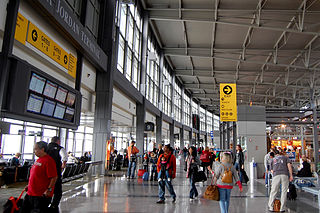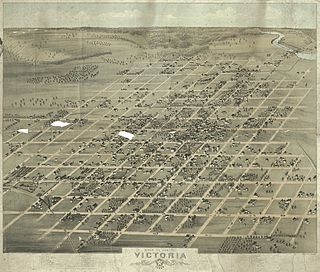Related Research Articles

David Gouverneur Burnet was an early politician within the Republic of Texas,serving as interim President of Texas,Vice President of the Republic of Texas (1839–1841),and Secretary of State (1846) for the new state of Texas after it was annexed to the United States.

Coahuila y Tejas was one of the constituent states of the newly established United Mexican States under its 1824 Constitution.

Mexican Texas is the historiographical name used to refer to the era of Texan history between 1821 and 1836,when it was part of Mexico. Mexico gained independence in 1821 after winning its war against Spain,which began in 1810. Initially,Mexican Texas operated similarly to Spanish Texas. Ratification of the 1824 Constitution of Mexico created a federal structure,and the province of Tejas was joined with the province of Coahuila to form the state of Coahuila y Tejas.

Bergstrom Air Force Base (1942–1993) was located seven miles southeast of Austin,Texas. In its later years it was a major base for the U.S. Air Force's RF-4C reconnaissance fighter fleet.

Del Valle is an airport-defined edge city of Austin and part of the Austin–Round Rock–San Marcos Metropolitan Statistical Area. It is founded upon the 19th-century Santiago Del Valle leagues,the largest granted land parcel in Travis County.

McKinney Falls State Park is a state park in Austin,Texas,United States at the confluence of Onion Creek and Williamson Creek. It is administered by the Texas Parks and Wildlife Department. The park opened on April 15,1976 and is named after Thomas F. McKinney,a businessman,race horse breeder and rancher,who owned and lived on the land in the mid-to-late 19th century. The park is part of the El Camino Real de los Tejas National Historic Trail.

The McKinney Homestead is a former limestone home built between 1850 and 1852 by Thomas F. McKinney,owner of the surrounding land. The two-story homestead was continuously occupied until it burned in the 1940s.
East Riverside-Oltorf is a neighborhood in Austin,Texas,located southeast of the city's urban core. The East Riverside,Parker Lane,and Pleasant Valley neighborhoods together form the East Riverside-Oltorf Combined Neighborhood Planning Area. The region is bounded on the north by Lake Lady Bird,to the east by Grove Boulevard and the Montopolis neighborhood,Texas State Highway 71 to the south,and Interstate 35 and South River City to the west.

Michel Branamour Menard (1805–1856) was a Canadian-born trader and merchant,first active on the upper Mississippi River and later in Texas. He co-founded Galveston,Texas. He represented Galveston County in the Congress of the Republic of Texas.
Plácido Benavides (1810–1837) was an early Mexican-born settler in De Leon's Colony,Victoria County,Texas. Benavides earned himself the sobriquet of the Paul Revere of Texas for his 1836 journey from San Patricio to Goliad to Victoria,warning residents of the approaching Mexican army. He was twice elected alcalde of Victoria,Texas. He married into the powerful De León family,and with his wife Agustina became the father of three daughters. Benavides fought against the dictatorship of Antonio López de Santa Anna,but did not feel Texas should be separated from Mexico.

De León's Colony was established in 1824 in northern Coahuila y Tejas state of the First Mexican Republic,by empresario Martín De León. It was the only ethnically Mexican colony founded during the Mexican period (1824-1835) that is located within the present-day U.S. state of Texas.

Robertson's Colony was an empresario colonization effort during the Mexican Texas period. It is named after Sterling C. Robertson,but had previously been known by other names. It has also been referred to as the Nashville Colony,after the Tennessee city where the effort originated,the Texas Association,the Upper Colony,and Leftwich's Grant,named after early colonizer Robert Leftwich. The eventual contract spread over an area that includes all or part of thirty present-day counties in Texas.

Samuel May Williams was an American businessman,politician,and close associate of Stephen F. Austin,who was an Anglo-American colonizer of Mexican Texas. As a teenager,Williams started working in the family's mercantile business in Baltimore. He spent time in South America and New Orleans,fleeing the latter because of debts. He landed in Mexican Texas in 1822,having learned French and Spanish. Stephen F. Austin hired Williams for his colony in 1824. Williams first worked as a clerk,and later assumed the title of secretary to the ayuntamiento,a local government established for the colony by the Mexican state of Coahuila and Texas. He worked for Austin for about a decade.

Sarahville de Viesca or Fort Milam or Bucksnort is a ghost town in Falls County,Texas,United States. The settlement was established in 1834 by Sterling C. Robertson and named for his mother Mrs. Sarah Robertson and Agustín Viesca,the Mexican governor of Coahuila y Tejas. The site was located at the falls of the Brazos River,where the river formerly dropped 10 feet (3 m) and where a well-used ford was located. The town was temporarily deserted in 1836 during the Runaway Scrape and permanently abandoned soon afterward because of native American raids. Fort Milam was built on the west-bank site but abandoned a few years later in favor of the town of Bucksnort which occupied the east bank. Bucksnort vanished when the nearby town of Marlin was founded. There is a county park and historical marker located where Farm to Market Road 712 crosses the Brazos south of Marlin.

Thomas Freeman McKinney was a trader,merchant,and a co-founder of Galveston,Texas. Living with his family in the western states of Kentucky,Illinois,and Missouri,he started trading in Mexico in 1823. The next year he settled in Stephen F. Austin's Colony,claiming a headright to Texas land while continuing his trading activities. He established a partnership with Samuel May Williams in 1834,and they operated a warehouse at the mouth of the Brazos River. The McKinney &Williams partnership loaned money and vessels to the cause of Texas independence. After Texas gained independence from Mexico,McKinney co-founded Galveston,Texas,and the McKinney &Williams company set up a warehouse and dock in the new town. McKinney later sold his share of the McKinney &Williams partnership and retired to Travis County,Texas.

The Judge Sebron G. Sneed House is a historic former limestone plantation house in Austin,Texas,commissioned by Judge Sebron Graham Sneed. It was likely designed by architect and general contractor,Abner Hugh Cook,co-owner of the sawmill where Sneed had purchased lumber for the construction of the house. Cook is most notable for designing the Texas Governor's Mansion in Austin.

Jose Miguel de Arciniega (1793–1849) was a Mexican military explorer and legislator. He was mayor of San Antonio,Texas,in 1830 and 1833.
References
- ↑ Haynes, Sam W. (September 1, 2015). Contested Empire: Rethinking the American Revolution. Texas A&M University Press. p. 87. ISBN 9781623493103.
- 1 2 3 Clark, John W. Jr. "Del Valle, Santiago". Texas State Historical Association. Retrieved June 30, 2019.
- 1 2 Garver, Lois. "MILAM, BENJAMIN RUSH". The Handbook of Texas. Texas State Historical Society. Retrieved 20 February 2015.
- ↑ "Menard, Michel Branamour". Handbook of Texas Online, Texas State Historical Association. Retrieved October 4, 2009.
- ↑ "The Galveston Collection". Texas Archival Resources Online, University of Houston. Archived from the original on May 1, 2008. Retrieved October 4, 2009.
- ↑ Henson, Margaret Swett. McKinney Falls. The Texas State Historical Association, 1999.
- ↑ Denney, Richard (September 7, 2009). "Santiago del Valle Grant". Historical Marker Database. Retrieved June 30, 2019.
- 1 2 United States Department of Interior (April 1996). "Rural Development and Building Traditions in Southeastern Travis County: 1846-1946". Historic and Architectural Resources of Southeast Travis County, Texas. Retrieved July 7, 2019.
- ↑ Texas Parks & Wildlife Department. "McKinney Falls State Park". State of Texas. Retrieved June 30, 2019.